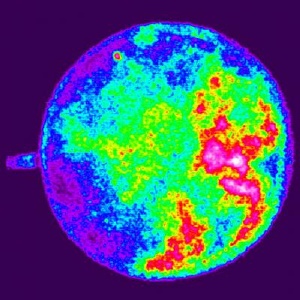Apr 10 2008
There's a strange wave phenomenon that's plagued rocket scientists for years, a lurking threat with the power to destroy an engine at almost any time. For decades, scientists have had a limited understanding of how or why it happens because they could not replicate or investigate the problem under controlled laboratory conditions.
 An image of destructive acoustic waves building inside a small, simulated rocket combustor. (Credit: Georgia Institute of Technology)
An image of destructive acoustic waves building inside a small, simulated rocket combustor. (Credit: Georgia Institute of Technology)
Scientists generally believe that these powerful and unstable sound waves, created by energy supplied by the combustion process, were the cause of rocket failures in several U.S. and Russian rockets. Scientists have also observed these mysterious oscillations in other propulsion and power-generating systems such as missiles and gas turbines.
Now, researchers at the Georgia Institute of Technology have developed a liquid rocket engine simulator and imaging techniques that can help demystify the cause of these explosive sounds waves and bring scientists a little closer to being able to understand and prevent them. The Georgia Tech research team was able to clearly demonstrate that the phenomenon manifests itself in the form of spinning acoustic waves that gain destructive power as they rotate around the rocket's combustion chamber.
“This is a very troublesome phenomenon in rockets,” said Ben Zinn, the David S. Lewis Jr. Chair and Regents' Professor in the Guggenheim School of Aerospace Engineering at Georgia Tech. “These spinning acoustic oscillations destroy engines without anyone fully understanding how these waves are formed. Visualizing this phenomenon brings us a step closer to understanding it.”
The research was presented at the 2008 American Institute of Aeronautics and Astronautics (AIAA) Aerospace Sciences Meeting in Reno, Nevada, and funded by the Air Force Office of Scientific Research.
During past investigations into this damaging instability, scientists were able to observe initial stages of the problem but were forced to shut down engines before the waves could fully develop and cause serious damage to the engine. Researchers were also hindered by their inability to clearly observe the complex processes inside the investigated rocket engines.
But with a great deal of help from Dr. Oleksandr Bibik, a visiting physicist and research scientist from Ukraine, the Georgia Tech research team developed an experimental setup and imaging technique that provides detailed information on how these waves form and behave — without blowing up an engine or endangering lives.
First, the researchers developed a low-pressure combustor that serves as a true simulator of larger rocket engines. Bibik then used a very-high-speed camera in combination with series of fiber optic probes that together allowed researchers to clearly observe the formation and behavior of excited spinning sound waves within the engine. Additionally, Bibik's new imaging method enabled researchers to determine the conditions under which these waves are excited and how they can be controlled.
Bibik's method uses a high-speed camera to view the reaction zone via a system of filters that allow only specific light radiation generated in the combustion zone to reach the camera's lens. This strategy eliminates all background light interference and provides clear images of combustion (and sound) waves spinning around the engine's periphery. Simultaneously, strategically placed fiber optic probes collect information on the reaction process oscillations in various locations in the combustor.
Using these new techniques, the research team discovered that the destructive waves gained energy as they spun around the engine's periphery at a rate of 5,000 revolutions per second.
The capability to simulate and observe these destructive oscillations in a controlled laboratory environment could help researchers develop techniques to prevent their occurrence in real engines.
“Better understanding this phenomenon could very likely lead to safer tactical and space missions and save billions of dollars for technologies that use combustors,” Zinn said.